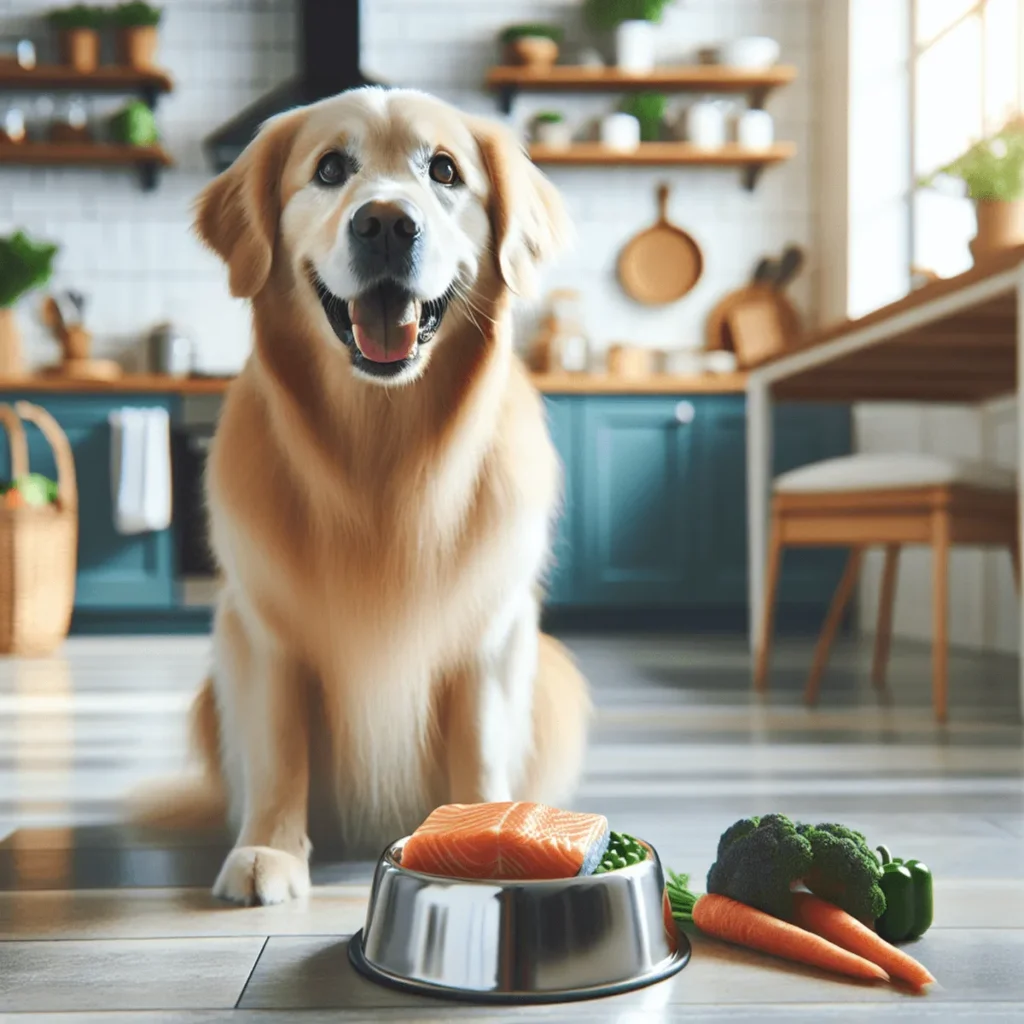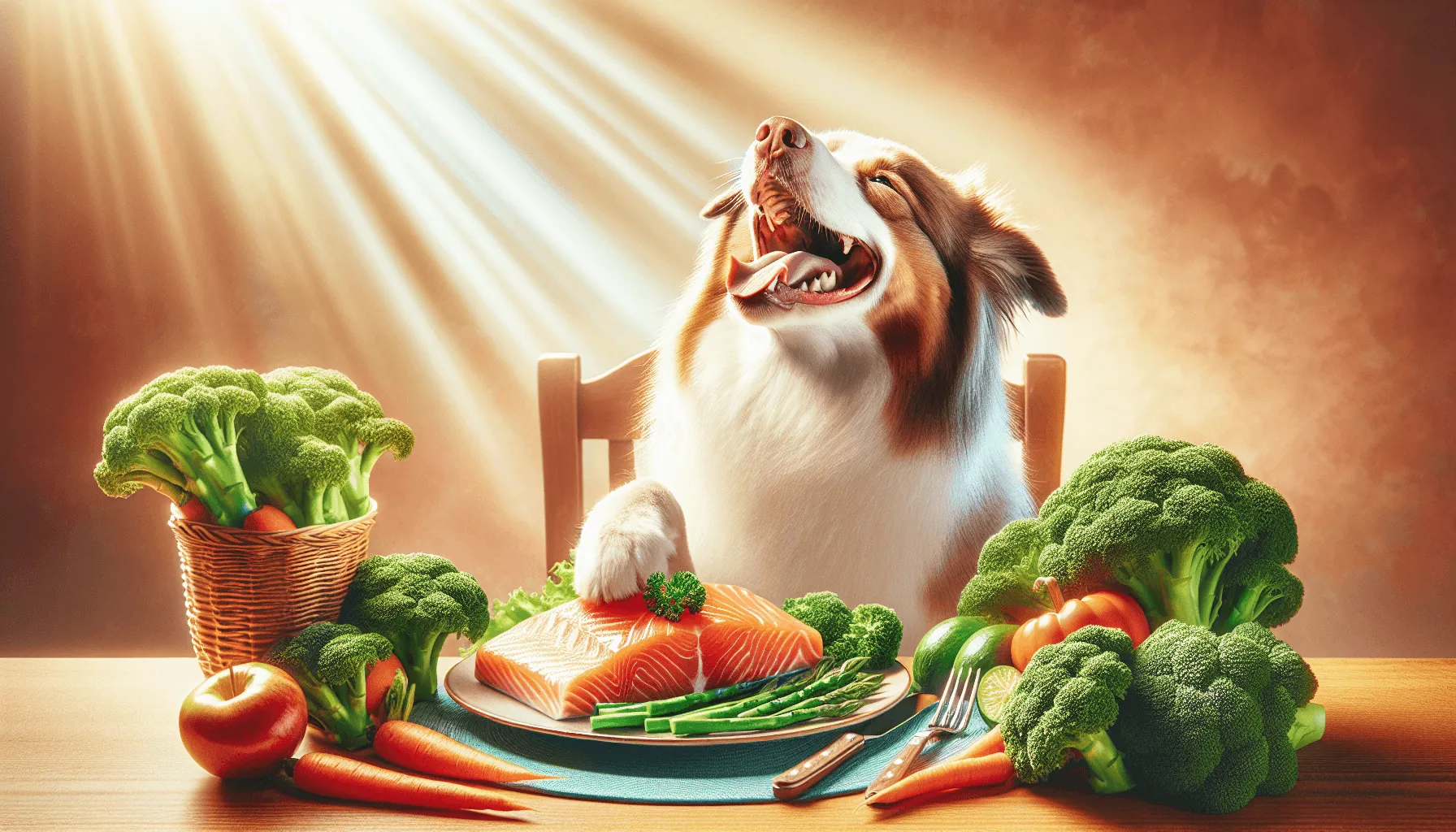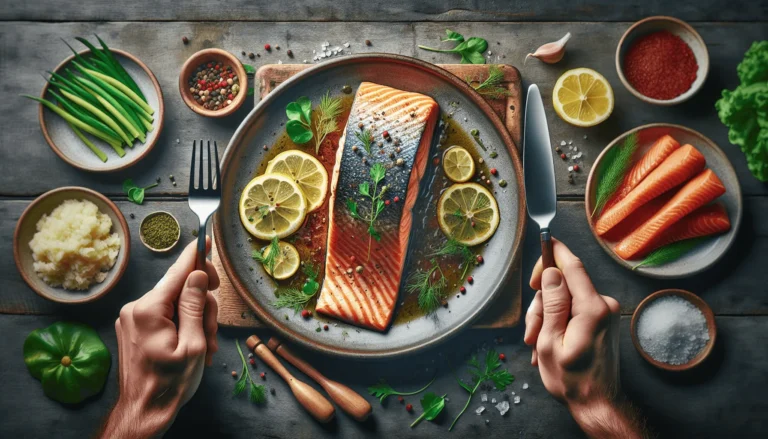Salmon is packed with essential nutrients that can benefit your dog. It contains:
- Omega-3 fatty acids: Promote a healthy coat and skin, reduce inflammation, and support overall joint health.
- B vitamins (especially B12): Aid in energy production, red blood cell formation, and proper nervous system function.
- High-quality protein: Crucial for muscle development and maintenance.
Can Dogs Eat Salmon? A Comprehensive Guide
Understanding both the benefits and risks of feeding salmon to your furry friend is vital. While it provides valuable nutrients, certain precautions must be taken to ensure their safety. This comprehensive guide will help you navigate the complexities of including salmon in your dog’s diet safely.
Read Also: Delicious Smoked Salmon Recipes – Top 10 You Must Try.
Nutritional Benefits of Salmon for Dogs

Salmon offers several key nutrients that can enhance your dog’s health:
Omega-3 Fatty Acids
Omega-3 fatty acids are crucial for a dog’s overall well-being. These healthy fats help:
- Reduce inflammation
- Promote a shiny coat and healthy skin
- Support joint health
- Boost the immune system
Including salmon in your dog’s diet provides these essential fatty acids, contributing to their long-term health.
B Vitamins, Particularly Vitamin B12
Salmon is rich in B vitamins, especially vitamin B12. This vitamin plays a vital role in:
- Maintaining healthy nerve function
- Supporting red blood cell formation
- Enhancing energy metabolism
A sufficient intake of vitamin B12 ensures that your dog remains energetic and healthy, preventing issues like anemia and lethargy.
Read Also: How Long to Bake Salmon at 400°F? Tips & Recipes.
Protein Content
Protein is another significant component of salmon. It is essential for:
- Building and repairing tissues
- Producing enzymes and hormones
- Supporting muscle growth and maintenance
Adding salmon to your dog’s diet provides high-quality protein, ensuring they get the necessary amino acids for optimal health.
By incorporating salmon into your dog’s meals, you can offer them these nutritional benefits, enhancing their overall vitality.
Safe Ways to Feed Salmon to Dogs

Ensuring your dog’s safety when feeding them salmon starts with proper preparation. Cooked salmon is the safest option, as cooking thoroughly eliminates harmful parasites.
Recommended Preparation Methods
Cooking methods such as:
- Baking: Place salmon fillets on a baking sheet lined with parchment paper and bake at 350°F (175°C) for about 15-20 minutes until fully cooked.
- Grilling: Preheat the grill to medium-high heat, place the salmon on a grill tray or foil, and cook for 10-15 minutes, turning once.
These methods ensure that you avoid adding unnecessary fats or spices that may be harmful to your dog.
Read Also: Cooking Salmon on the Stove – 5 Tips for Perfect Fillets.
Canned Salmon
If you choose to feed your dog canned salmon, consider these guidelines:
- Low Sodium Options: Opt for canned salmon labeled “low sodium” to prevent excessive salt intake.
- Rinsing Before Serving: Rinse the canned salmon under cold water to remove any excess salt.
These precautions help in providing a safer and healthier meal for your pet.
By focusing on these preparation techniques, you can offer nutritious and safe salmon treats to your dog.
Types of Salmon and Their Safety for Dogs
Raw and Undercooked Salmon: Risks to Consider
Can dogs eat raw salmon? It’s a common question among pet owners. The answer is a resounding no. Raw and undercooked salmon pose significant health risks for dogs due to the presence of Neorickettsia helminthoeca, a parasite responsible for salmon poisoning disease. Symptoms include:
- Vomiting
- Diarrhea
- Lethargy
- Lack of appetite
These symptoms can be fatal if not treated promptly, making it crucial to avoid feeding your dog raw or undercooked salmon.
Read Also: Manta Ray vs. Stingray – 10 Key Differences
Smoked Salmon: High Salt Content Warnings
Can dogs eat smoked salmon? It’s best to avoid it. Smoked salmon contains high levels of salt and potential carcinogens. High salt intake can lead to sodium ion poisoning, causing symptoms such as:
- Extreme thirst
- Vomiting
- Diarrhea
- Seizures in severe cases
Wild-Caught vs. Farmed Salmon: Safety Comparison

When considering can dogs eat salmon, it’s important to distinguish between wild-caught and farmed varieties.
Wild-Caught Salmon:
- Generally lower in contaminants like heavy metals.
- Lower risk of exposure to antibiotics and GMOs.
Farmed Salmon:
- Potentially higher in harmful substances, including pesticides and antibiotics as highlighted in this informative article from The Guardian.
- Risk of GMOs that might lead to health issues.
Both types should always be cooked thoroughly before being offered to your dog. This ensures any potential parasites or toxins are eliminated, making the fish safe for consumption. For more insights into the differences between these two types, you can refer to this comprehensive guide on farmed vs wild salmon.
Potential Risks of Feeding Salmon to Dogs
Salmon Poisoning Disease
Salmon poisoning disease poses a significant risk when feeding dogs raw or undercooked salmon. This disease is caused by the Neorickettsia helminthoeca parasite, which can be deadly for dogs. Symptoms include:
- Vomiting
- Diarrhea
- Lethargy
- Lack of appetite
- Fever
If left untreated, salmon poisoning disease can be fatal within 14 days.
Toxins in Salmon
Certain types of salmon may contain harmful toxins, including:
- Heavy Metals: Salmon can accumulate heavy metals such as mercury and lead. These toxins can lead to neurological issues and other health problems in dogs.
- Radiation: Events like the Fukushima nuclear accident have raised concerns about radiation contamination in Pacific salmon.
These risks underscore the importance of choosing high-quality, safe sources of salmon for your dog.
Recommended Serving Sizes Based on Dog Size
Determining the appropriate serving size of salmon for your dog depends largely on their weight. Here are some guidelines:
- Small dogs (up to 20 lbs): 1-2 ounces of cooked salmon per serving.
- Medium dogs (20-50 lbs): 2-4 ounces of cooked salmon per serving.
- Large dogs (50+ lbs): 4-6 ounces of cooked salmon per serving.
Before introducing salmon into your dog’s diet, it’s crucial to do so gradually to monitor any adverse reactions. Start by offering a small amount, such as a teaspoon, mixed into their regular food. This method is part of a broader strategy on safely changing your dog’s diet.
As you begin this process, observe for any negative reactions such as vomiting, diarrhea, or itching. If no adverse symptoms occur, gradually increase the portion size over a week. This incremental approach helps ensure that the addition of salmon is safe and well-tolerated by your dog.
Remember that while salmon can be a beneficial part of your dog’s diet, it’s important to consider if dogs can eat fish and to follow specific guidelines on how to switch your dog’s food for optimal health.
Alternatives to Salmon for Omega-3 Fatty Acids
If you’re looking to add more variety to your dog’s diet besides salmon, here are some other options that are high in omega-3 fatty acids:
- Green-lipped mussels: These are an excellent source of omega-3s and also provide other beneficial compounds like glucosamine and chondroitin, which support joint health.
- Flaxseed oil: This can be easily added to your dog’s food. Flaxseed oil is plant-based and provides a good supply of omega-3s.
- Chia seeds: Another plant-based option, chia seeds are high in omega-3s and can be sprinkled on your dog’s meals.
- Organ meats: Liver and kidney from various animals not only offer omega-3 fatty acids but also provide a range of other vital nutrients, making them a healthy dog treat.
Incorporating these alternatives ensures that your dog receives the essential fatty acids they need without the risks associated with consuming salmon.
Read Also: Braided Line vs Mono: Pros & Cons
Conclusion: Is Salmon Safe For Your Dog?
Feeding dogs salmon can offer numerous health benefits, such as omega-3 fatty acids and essential vitamins. To maximize these benefits and minimize risks:
- Cook salmon thoroughly to eliminate parasites.
- Choose low sodium canned salmon and rinse before serving.
- Avoid raw, undercooked, or smoked salmon due to potential toxins and high salt content.
A balanced diet is key. When you inform about feeding dogs salmon, always consider safe food practices. Understanding the health benefits of salmon for dogs ensures you provide a nutritious addition to their diet.
FAQs (Frequently Asked Questions)
Can dogs eat salmon?
Yes, dogs can eat salmon, but it should be cooked thoroughly to eliminate parasites. It’s important to understand both the benefits and risks involved.
What are the nutritional benefits of salmon for dogs?
Salmon is rich in omega-3 fatty acids, B vitamins (particularly vitamin B12), and protein. Omega-3s support a healthy coat and skin, while protein is essential for muscle development.
How should I prepare salmon for my dog?
Salmon should be cooked properly, preferably by baking or grilling. Avoid feeding raw or undercooked salmon due to the risk of parasites. If using canned salmon, opt for low sodium options and rinse before serving.
Are there any risks associated with feeding salmon to dogs?
Yes, there are risks such as salmon poisoning disease caused by Neorickettsia helminthoeca. Additionally, certain types of salmon may contain heavy metals that can be toxic to dogs.
What are the recommended serving sizes of salmon based on dog size?
Serving sizes should be determined based on your dog’s weight. It’s advisable to introduce salmon gradually into their diet to monitor for any adverse reactions.
What alternatives can I offer my dog for omega-3 fatty acids?
Alternatives to salmon for omega-3 fatty acids include healthy dog treats, green-lipped mussels, and organ meats, which are safer options for your dog’s diet.




